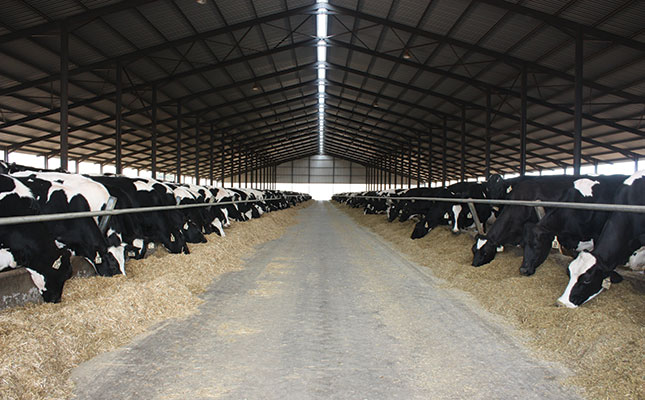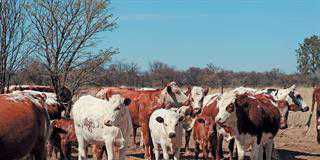
Photo: FW Archive
Subacute rumen acidosis (SARA), is a digestive disorder found mostly in high-producing dairy herds and intensively fed beef and sheep operations. It is the result of a low acidity level (pH), or fast and drastic pH changes, in a cow’s rumen, typically due to incorrect feeding management.
According to Dr Chris van Dijk, Milk Producers’ Organisation (MPO) CEO and specialist vet, speaking at a recent MPO symposium, a dairy cow’s rumen pH should optimally vary between 6,4 and 6,5. If the pH drops below 5,8, SARA results.
“In high-producing cows, rumen acidosis (pH <6) is a common problem. Rumen acidosis is usually associated with the ingestion of large amounts of highly fermentable, carbohydrate-rich feed, which results in excessive production and accumulation of lactic acid in the rumen,” Chris says.
SARA occurs when rumen pH stays between 5,2 and 6 for a number of hours for several days at a time, he says.
Farmers are often more familiar with acute rumen acidosis (suurpens), but the subacute type can often cause more harm as it remains undetected in entire herds for long periods, Chris explains.
READ Consumers must be informed about dairy substitute drinks
Not only does SARA have an adverse impact on the welfare of a herd, as cows suffer for long periods without any obvious clinical symptoms, but it also leads to large financial losses due to a decline in milk yields, and thus reduced profits. The lifespan of cows is also drastically reduced.
Identifying SARA
Between 10% and 40% of all dairy cows will suffer from SARA at some stage in their productive life, and producers must thus endeavour to prevent this.
However, cows suffering from SARA first need to be identified, and this can be challenging as the clinical symptoms are often not obvious.
The butterfat content of milk can be used as a diagnostic tool to identify the presence of SARA in a herd, Chris says.
“Butterfat must be between 3,3% and 4,5%, and if it is less than 2,2% in more than 10% of cows in the herd, there is a problem in the herd. However, it is often not evident in a bulk tank as the problem lies with individual cows.”
Thus, when a milk buyer reports a reduced butterfat content in the milk supplied from a specific farming operation, there is a significant chance of SARA being present in a large number of cows in the herd, Chris says.
Another clear clinical indicator that SARA may be present is a decline in dry matter intake. A decline as high as 25% has been observed in some herds in which SARA is present.
Large daily variances in dry matter intake are also indicative of SARA.
Another indicator is cows suffering from laminitis. If more than 10% of cows in a herd manifests with laminitis at any given stage, the possible presence of SARA must be investigated.
Cows afflicted with laminitis will frequently be observed standing in water to cool down their hooves, due to the inflammation caused by laminitis.
Excessively high culling numbers, which cannot be adequately explained, are another indication.
“If the cull rate exceeds 31%, one must suspect SARA, while a decline in the number of cows ruminating is an additional indicator. Rumination is important as it stimulates saliva production, which acts as a buffer during the fermentation process in the rumen and prevents the production of ‘bad’ rumen bacteria.
Between 100ℓ and 140ℓ of saliva is produced in a cow’s mouth per day,” Chris explains.
The only conclusive way in which to assess a cow’s rumen pH, is by drawing fluid from the rumen through percutaneous needle aspiration (rumenocentesis) and assessing the pH, Chris says.
Monitoring manure
Varying manure consistency in a group of cows can also indicate the presence of SARA, with many cows having loose, ‘bubbly’ faeces.
This manure often has a bright yellowish colour, and smells sour. The pH of manure associated with SARA is also lower than normal, but using manure pH as an indicator is not often accurate.
The manure can also contain higher than normal levels of undigested grains or fibre, Chris says. In addition, you may observe mucin casts, which are long strands of mucous in dung.
Cows may also be more susceptible to SARA duringthe post-partum period, due to the diminished size and absorptive capacity of rumen papillae following feeding on lower energy density diets during dry periods.
Some field studies revealed SARA in 11% to 29,3% of cows during early lactation, and 18% to 26,4% of cows during mid-lactation. But, farmers often see mortalities during late lactation as well.
This is often due to lower feed intake that results in lower feed passage rates, and therefore slower outflow of volatile fatty acids from the rumen, resulting in lower pH due to a build-up of these acids.
“In summer, atypical avoidance of feeding due to heat stress associated with high temperatures may also lead to SARA. Cows suffering from heat stress eat less frequently, but consume larger portions, which creates the problem,” Chris says.
Cows that are at the beginning of their lactation period are also susceptible as their rations are changed to high energy feed, and they need a rumen adjustment period, which they are often not given.
Mixing feed
Cows always experience a negative energy balance during the first 100 days after calving, and rations have to be formulated to rectify this. However, not carefully managing the change in rations could lead to SARA developing.
This problem worsens as milk production rises, resulting in an even greater possibility of feed ‘mistakes’ occurring.
“Many farmers mix their own feed as they want to save costs. However, a feed specialist has to be part of a dairy farm’s mixing team,” Chris says.
According to feed specialist, Kenneth Botha, incorrect mixing of feed does not only lead to disorders such as SARA, but also results in financial losses due to lower milk solid content, poor reproduction, and increased incidence of laminitis.
“Those mixing dairy cattle feed on-farm have to meet certain accuracy levels to ensure that disorders such as SARA do not surface. One needs advice from a nutritionist, quality raw materials, good record-keeping for inputs, and mixers that are in good condition to prevent mixing mistakes,” he says.
Having an evaluation system for feed mixer operators is also critical.
“Total mixed rations [TMR] consists of roughage, grains, protein sources, vitamins and minerals, and feed additives. If you want to mix feed successfully on-farm, you need to know that the ration is correct.”
A good mixer operator must be carefully trained and managed, by, for example, learning about the necessary waiting periods between adding ingredients to the mix. Some farmers use computer programs to assist them in managing the operators, who are often paid according to the accuracy achieved in mixing rations.
“The accuracy not only refers to a mix, but also to consistent feed delivery; cows always like their feed at the same time every day,” Kenneth says.
Managing equipment
Challenges with feed mixing are experienced on multiple levels. One of the first things to look at is maintenance plans for augers or stationary mixers, as this is the first area where mixing can be detrimentally affected.
“In South Africa, maintenance is neglected, while elsewhere in the world it is a major focus. I sometimes arrive on farms where SARA is present, only to find that there aren’t blades in the auger mixers and feed was mixed incorrectly,” he says.
According to Kenneth, those farmers with cows that consistently yield more than 35ℓ/ day/cow, say they focus on mixer accuracy and consistency in feed mixes.
Kenneth recently visited a dairy farm, with a 41ℓ parlour average for 2 000 cows, where a manager signs off every feed mix before it is fed to cows. This evaluation is based on fibre length and proper mixing, which is based on a visual inspection.
These operators are also trained to use the Penn State Particle Separator (PSPS) to evaluate mixes every day to ensure consistency and accuracy.
Mixing accuracy is also dependent on the equipment used, and farmers who want to mix their own protein or mineral packs into TMR will need very precise equipment, if, for example, 10g/cow of a given mineral or additive has to be mixed into several tons of feed.
The smaller the quantity per cow/day, the more expensive the equipment becomes. These smaller quantities are often more toxic if mixed incorrectly, and have to be evenly distributed throughout the feed. Unfortunately, farmers do not always invest in sophisticated mixers to ensure accurately mixed rations, he explains.
Kenneth recommends that mixers are never filled to more than 70% or 80% of capacity as raw materials often spill over the edges during mixing, which affects the accuracy of the mix.
Kenneth cites an example where he was asked to assist with SARA, and says he immediately saw that roughage was added to the TMR mix last. Therefore, as the mixer was overloaded, roughage simply spilled over the edge of the mixer.
The farm had lost 48 cows in a short period of time, due to inaccurate mixing, which resulted in SARA developing. Some mixers can also only weigh quantities that are above a certain threshold and would not be able to register very low weights.
Raw materials
The next step is analysing the raw materials, and Kenneth says it should be sent back to suppliers if the required quality standards are not met. For example, mixing in coarse maize would mean that cows eat the (palatable) maize that is separated to the bottom of the feed trough first, and this could lead to SARA developing.
“One also needs to analyse soya and sunflower protein content, and the sugar/ brix count of molasses. Chop also has to have a certain amount of moisture, as one only pays for the starch content. A difference of 60,3% versus 76,3% starch content in maize can mean up to 2ℓ/ day milk change in yield on some farms,” he says.
On top of this, storage will also affect feed, with between 5% and 10% of maize being lost as a result of incorrect storage and grinding.
This loss has to be added into ration cost calculations. On another farm Kenneth recently visited, 950t of maize was being fed to 350 cows/annum.
The maize was milled on-farm, initially using an open hammer mill, which resulted in losses of 3% to 4% (32,4t) per year. Using a closed mill reduced this to 1,8% (17,1t). With the former method, losses amounted to about R58 320/year.
“There are four kinds of rations; the one that is formulated on paper, the one that is mixed, the one that is fed, and the one that’s eaten. Make sure what was formulated is in fact eaten every day,” says Chris.
Email Dr Chris van Dijk at [email protected], or Kenneth Botha at [email protected].











